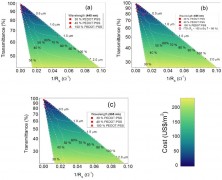Semiconducting polymers are a key ingredient in organic light emitting diodes (OLEDs), organic photovoltaics (OPVs) and organic field effect transistors (OFETs) – and pave the way for future bendable electronic devices. The technology is driving advances in the design of flexible displays, conformable energy harvesters, and wearable sensors to name just a few applications. What’s more, thanks to their solubility in many organic solvents, semiconducting polymers provide device makers with a range of appealing fabrication options including ink-jet printing, spray-coating and roll-to-roll production.

Graphical guidelines: a series of figure of merit charts show the interplay between key performance parameters for different blends and film thicknesses of PEDOT:PSS/PVA (Olivia Carr et al 2015 Transl. Mater. Res. 2 015002).
Optimizing the composition of the blended film is important to balance the cost versus performance. In many cases, high electrical conductivity and high optical transmittance in the visible range of the electromagnetic spectrum are critical factors. However, other aspects such as flexibility, film formation, chemical stability and wettability can also play an important role in the choice of the material or the composition to be used, together with overall processing considerations.
Case study: semi-transparent electrodes for flexible optoelectronics
In a recent study, published in the journal Translational Materials Research (TMR), materials scientists have examined a blend comprising poly(3,4-ethylenedioxythiophene):polystyrene sulfonate (PEDOT:PSS) and polyvinyl alcohol (PVA), which can be used as a flexible, semi-transparent and highly-conductive material in electronic and optoelectronic devices. The electrical conductivity and optical transmittance of spray-deposited films of various thicknesses and blend ratios were evaluated to determine the most appropriate composition for optimal device performance and cost.
Presenting their results as a series of figure of merit diagrams, the researchers observe that it should be possible to decrease the PEDOT:PSS content in the blend down to 30% (by weight) and maintain an acceptable level of electrical conductivity for many applications.
Full details
Analysis of the electrical and optical properties of PEDOT:PSS/PVA blends for low-cost and high-performance organic electronic and optoelectronic devices
Olivia Carr et al 2015 Transl. Mater. Res. 2 015002
